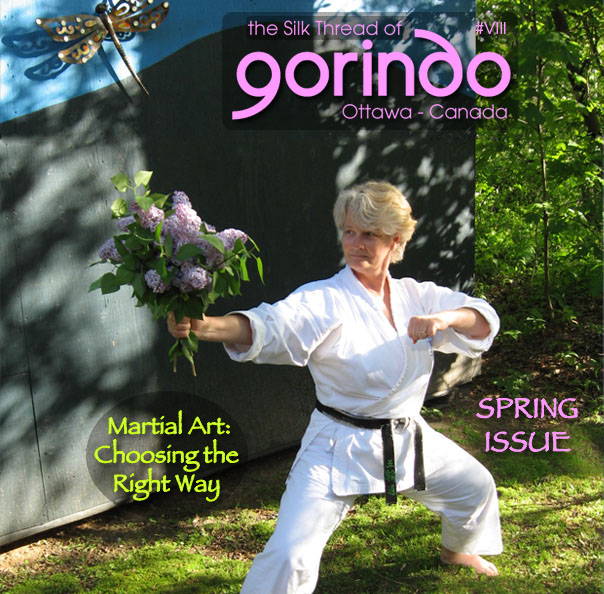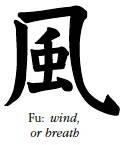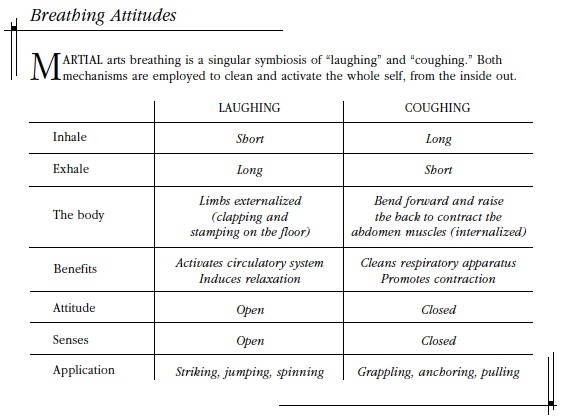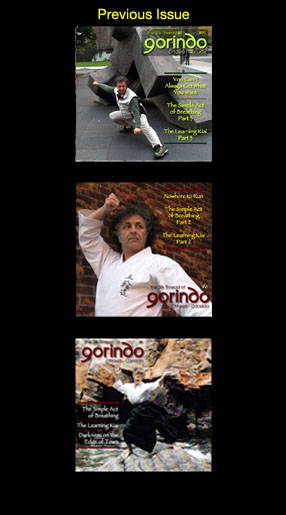
The Silk Thread of Gorindo - Ottawa - Canada
Issue VIII
- Martial Arts: Choosing the Right Way
- The Simple Act of Breathing (Part 4)
Photo cover Roxanne Standefer sensei at the Gorindo Dojo, Ottawa, May 2011, by Claudio Iedwab
The Simple Act of Breathing (Part 4)
< read Part 3 (previous issue)
 Prana is the Sanskrit word for the energy given off by the movement and flow of things in our universe, and is often associated with water and earth that is vibrant and alive. Breathing in the spray of waves crashing, waterfalls flowing, and the scent of verdant forests, fields, or jungles, has always brought joy and health to the human spirit. Whether viewed as the complex interactions of molecules of oxygen, hydrogen, nitrogen, and carbon-based life forms, or metaphysically as a divine union with ki (life force), this effect of Nature is basically what defines our lives as humans. The simple basis of the natural systems that allow us to exist should humble and amaze us, and the delicacy of the balance required for our survival deserves our respect.
Prana is the Sanskrit word for the energy given off by the movement and flow of things in our universe, and is often associated with water and earth that is vibrant and alive. Breathing in the spray of waves crashing, waterfalls flowing, and the scent of verdant forests, fields, or jungles, has always brought joy and health to the human spirit. Whether viewed as the complex interactions of molecules of oxygen, hydrogen, nitrogen, and carbon-based life forms, or metaphysically as a divine union with ki (life force), this effect of Nature is basically what defines our lives as humans. The simple basis of the natural systems that allow us to exist should humble and amaze us, and the delicacy of the balance required for our survival deserves our respect.
We Are What We Breathe
Even the trees breathe. It is not just poetic imagery to consider (what remains of) the large jungles and forests as the lungs of our planet. Deforestation caused by humankind is a serious threat to the intricate balance of ecosystems and the quality of the air we breathe. The oxygen supply of this ‘Spaceship Earth’ exists as a very thin skin around a planet of water, rock, and some organic matter. Although we feel the atmosphere is immense around us, at an altitude of 10,000 feet the air is appreciably thinner; it becomes difficult to breathe and the adjustment to different concentrations of elements in the air and in the bloodstream can make our organism feel quite unwell.
Breathing problems associated with pollution in urban environments arise not just because particulates in the air are inhaled, but also because of the imbalance of gases caused by the lack of oxygen-producing plants and trees in these concrete and asphalt environments. Protecting the air supply is just basic self-defense on both an individual and global level.
The martial artist not only exercises caution in avoiding polluted air but constantly seeks out opportunities to fill his or her lungs and spirit with clean, oxygenated and energized air. It is as vital to the feeding and function of the organism as food and water. This is why some martial arts are practiced outdoors in a natural environment. Although an ‘unlimited ceiling’ assists the practice of weapons technique (such as that of kyudo, kendo and iaido, as well as the staff and stick work of karate-do, gorindo, aikido and kali,) it is more to the point to understand that they are taught outside as joyful extensions of the mind, body and breath.
Breathing Out is the Key
Zazen breathing is used to prepare the mind and to focus reflexes with the intention that then every movement in the practice will arise and flow from the exhalation of the breath. Extending the reach of one’s control by ‘breathing out’ through the hands, and then through the ends of the tools or weapon, is a fundamental of these techniques. Similarly, the stroke of an ink brush on paper or the whisking of the brush in tea is the same as the slice and sweep of the blade of the samurai sword; it is the single breath of the artist.

Knowledge of and attitudes about breathing are one of the main areas of divergence between Western and Eastern ways of thinking, both culturally and historically. Western science took a very long time to recognize that germs and poisons could invade the body through inhalation. Medical science’s study of ventilation and respiration appears confined to clinical analysis of the human organism and its diseases. Resuscitation and artificial respiration are recognized as means of sustaining life, but little analysis of the importance of maintaining breathing as a useful tool of the body, or as an extension of the human mind and spirit has been done in modern Western culture. Interest in the conscious control of breathing mechanisms or its connection to personal health is almost conspicuous by its absence.
Perhaps historically the religious foundations of our social and artistic patterns did not allow for ‘the holy spirit’ to be associated with such mundane and profane human processes as breathing. Even though the ‘heart’ has been allowed to embody emotions and will, we don’t often lay bare its true simple function as an oxygen pump for a metabolic furnace. Emotionally, the martial artist observes how different circumstances and challenges can affect the breathing responses unconsciously. Through zazen and martial arts training the student can learn to reverse the roles, by taking control of one’s breathing patterns with the purpose of influencing thoughts and creating new situations. Adjusting one’s attitude can be simply reduced to exhaling the old completely and welcoming the new.
Who is that Breathing?
How our conscious thoughts and unconscious memories inhabit the physical machine of the human body is still mostly a mystery to the Western paradigm. The Eastern philosophies, religions, medicines, and educational systems on the other hand, place breathing prominently and centrally as a physical process and life force. It has a place as the fundamental point of departure for the study, teaching, expression and understanding of physiological processes and psychological, and philosophical points of view.
Excerpt from “The Secret Art of Health & Fitness – Uncovered from the Martial Arts Masters” by Claudio Iedwab & Roxanne Standefer
- Martial Arts: Choosing the Right Way
- The Simple Act of Breathing (Part 4)
« Click the Subscribe link on the left



